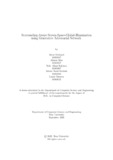| dc.contributor.advisor | Mukta, Jannatun Noor | |
| dc.contributor.author | Mahmud, Abrar | |
| dc.contributor.author | Sifar, Alimus | |
| dc.contributor.author | Rahman, Moh. Absar | |
| dc.contributor.author | Mostafa, Fateen Yusuf | |
| dc.contributor.author | Tasnova, Lamia | |
| dc.date.accessioned | 2023-10-16T04:24:43Z | |
| dc.date.available | 2023-10-16T04:24:43Z | |
| dc.date.copyright | ©2022 | |
| dc.date.issued | 2022-09-20 | |
| dc.identifier.other | ID 18201147 | |
| dc.identifier.other | ID 18201157 | |
| dc.identifier.other | ID 18201167 | |
| dc.identifier.other | ID 18201200 | |
| dc.identifier.other | ID 18301053 | |
| dc.identifier.uri | http://hdl.handle.net/10361/21832 | |
| dc.description | This thesis is submitted in partial fulfillment of the requirements for the degree of Bachelor of Science in Computer Science and Engineering, 2022. | en_US |
| dc.description | Cataloged from PDF version of thesis. | |
| dc.description | Includes bibliographical references (pages 57-59). | |
| dc.description.abstract | Global Illumination is a strategy in computer graphics to add certain degree of realism in case of 3D scene lighting, by trying to emulate how light rays work in real life. Several approaches exists to achieve such kind of visual effect for computed generated imagery. The most physically accurate approach is through ray-tracing. It can produce results which are realistic enough, with a trade-off of being time and computational-resource intensive, making them unsuitable for real-time usage. For more real-time usage scenarios, a set of faster algorithm exists that utilizes rasterization rather than ray-tracing. Despite being faster, those still can be resource intensive or generate physically inaccurate results. Our Generative Adversarial Net-work based approach targets to bring close to physically accurate results based on rasterization output data which can be obtained from a conventional deferred rendering pipeline, while retaining speed. These rasterization output data, which are basically screen-space feature buffers will act as the input to our deep-learning network, which in turn will produce per-frame lightmaps that contain global illumination data, which are further used to generate a presentable frame on the screen. Using screen-space information from a single viewpoint won’t always guarantee light consistency, thus our approach takes into account the rasterization output data of the surrounding of a certain viewpoint, producing more accurate global illumination. | en_US |
| dc.description.statementofresponsibility | Abrar Mahmud | |
| dc.description.statementofresponsibility | Alimus Sifar | |
| dc.description.statementofresponsibility | Moh. Absar Rahman | |
| dc.description.statementofresponsibility | Fateen Yusuf Mostafa | |
| dc.description.statementofresponsibility | Lamia Tasnova | |
| dc.format.extent | 71 pages | |
| dc.language.iso | en | en_US |
| dc.publisher | Brac University | en_US |
| dc.rights | Brac University theses are protected by copyright. They may be viewed from this source for any purpose, but reproduction or distribution in any format is prohibited without written permission. | |
| dc.subject | Computer graphics | en_US |
| dc.subject | Global illumination | en_US |
| dc.subject | Neural networks | en_US |
| dc.subject | GAN | en_US |
| dc.subject.lcsh | Neuropsychology | |
| dc.subject.lcsh | Rendering (Computer graphics) | |
| dc.title | Surrounding-aware screen-space-global-illumination using generative adversarial network | en_US |
| dc.type | Thesis | en_US |
| dc.contributor.department | Department of Computer Science and Engineering, BRAC University | |
| dc.description.degree | B.Sc. in Computer Science and Engineering | |

